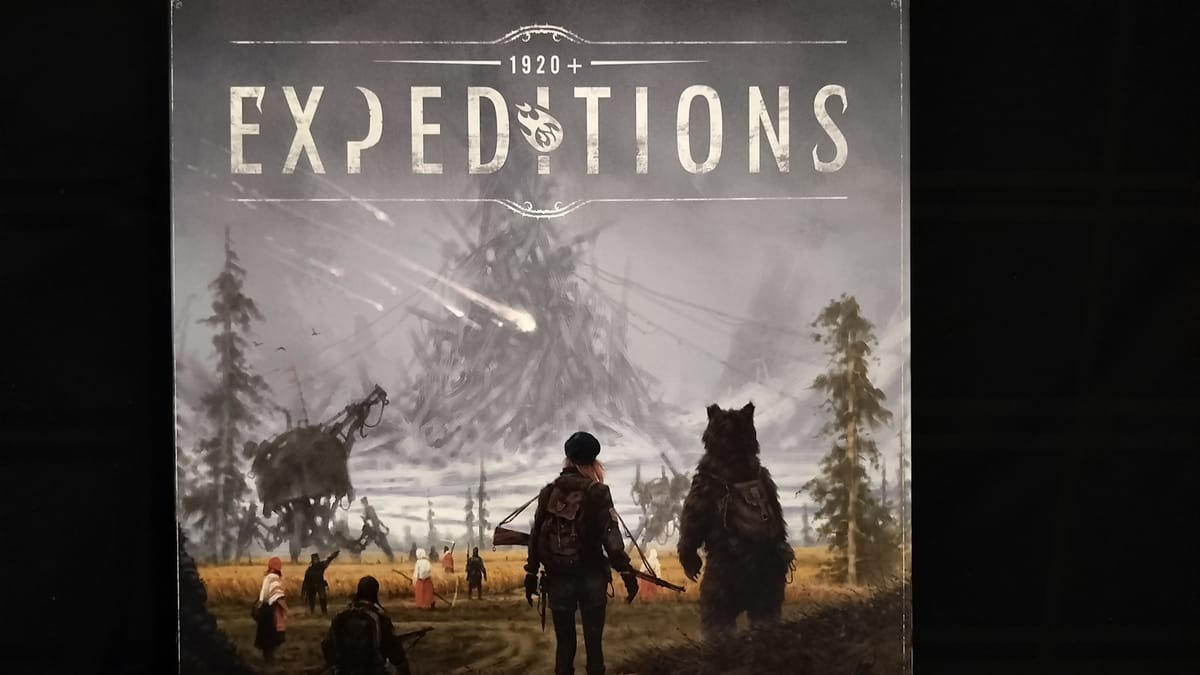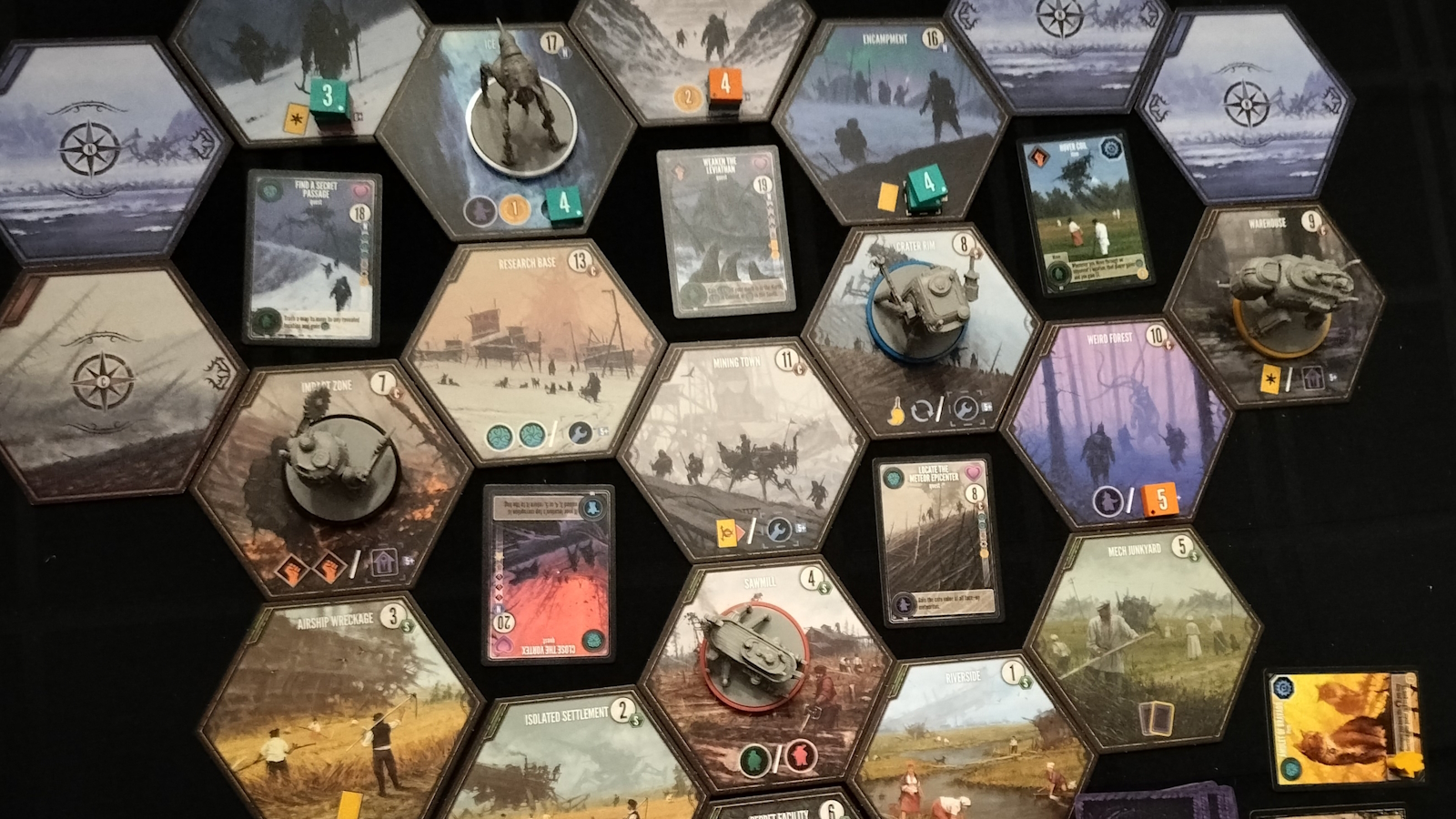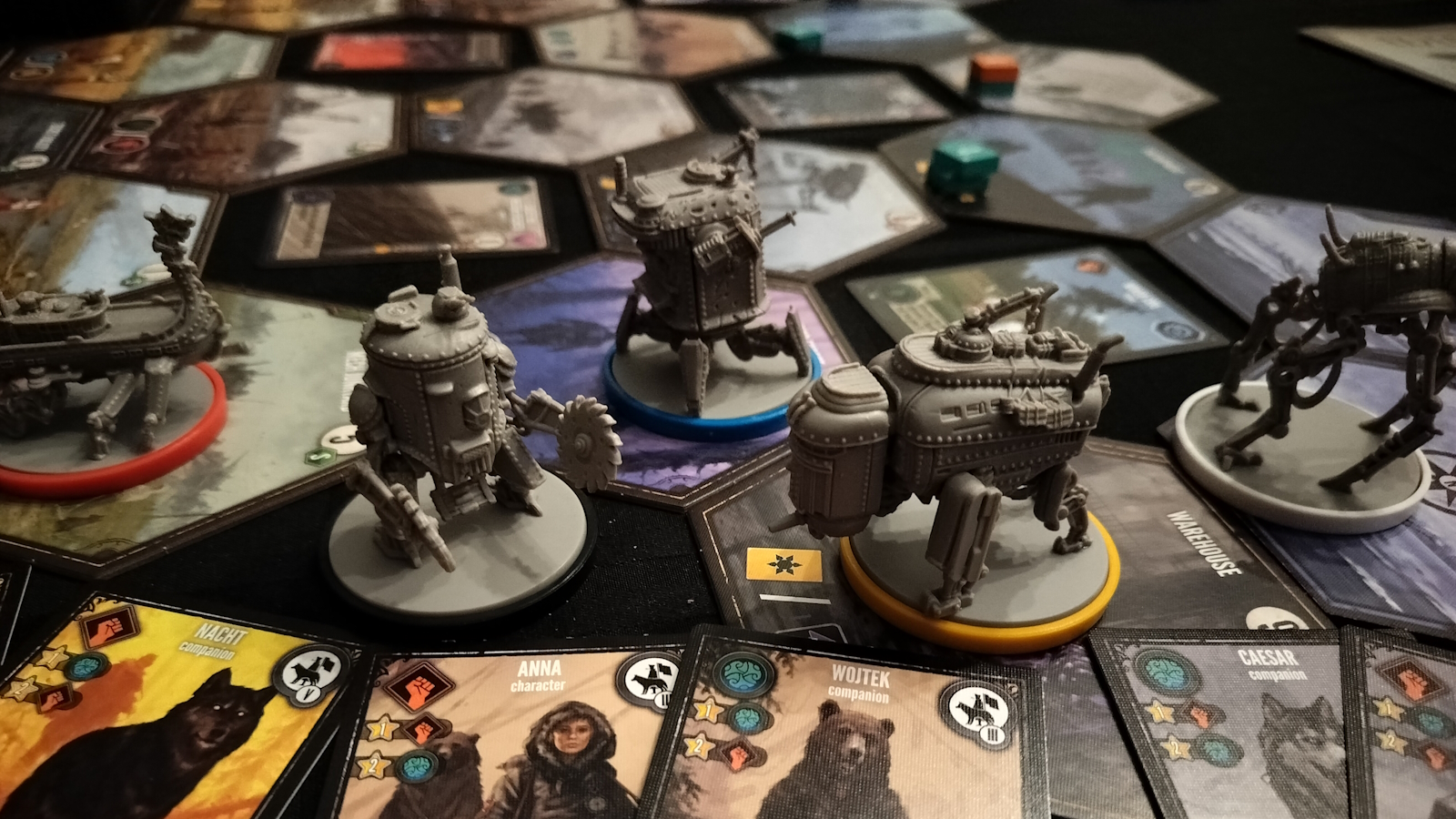
The world of Scythe is intriguing. Mostly told through the rulebook of Scythe and most especially Jakub Rozalski’s art, it follows a bunch of leaders and heroes from various altered European countries during an uneasy pre-World War 1 peace. There are weird things afoot, mostly from a place called the Factory, which are the source of the massive mechs that help define Jakub’s artistic vision as they stomp across pastoral scenes.
So when Expeditions, the sequel to Scythe, showed up, I was excited to dive deeper in this alternate history of mechs and mad science. In Expeditions, you take on the role of new and returning heroes of the Scythe world as they turn northward towards Siberia where something earthshaking happened. In our world, this was the Tunguska Event, where a meteor sped into Earth’s atmosphere and exploded before landing, creating an explosion and fires for miles and miles in the Siberian countryside.
In the world of Expeditions, instead of exploding upon entering the atmosphere, it lands and vile corruption starts oozing out of it. The effects aren’t very clear from the outset, but they become more clear the closer as our heroes get to the impact crater. Something wrong and alien has come to the world of Scythe, and it’s up to us to stop it… while making some money on the side.

And this is where the game stops being about the story. Expeditions is an adventure game set in the same world as Scythe that was marketed as a sequel. It plays up to 5 players, and includes an Automa for single player games. In it, each player gets a hero (and their pet) with unique abilities, an exploratory mech with unique abilities (and cool plastic mini), and set off to explore the frigid northern territory. The goal is to come out of the experience wealthier than the rest of the players.
Each turn, players will be able to choose from moving, gathering from their space, or playing cards from hand. On most turns, they will be able to do 2 of these things, but after any turn where they had to refresh their hand to get cards back, they can do all three. This primary mechanic is what drives players to make hard decisions, but doesn’t really lead to many interesting consequences.
The board is made up of large hex tiles, the majority of which start face down and randomized. This means that each game is unique, though the placement of the tiles doesn’t have a huge impact on the game, with a few exceptions. When players take the Move action, they can move their mech up to 3 locations, but must move at least 1, and must stop if they land on an unexplored tile, and cannot stop on top of another player. The tile then flips over, revealing its abilities, and the player who revealed it gets an exploration token, which can be used as a currency or as a means towards one of the objectives.
The Gather action activates a tile’s abilities. Most often, this means getting a card, which either comes from one of the five face up cards between each tile, or directly from the deck. Most of the time, these go to your played section of cards, meaning you’ll have to refresh to actually do something with those cards. There are other options, though, which relate to certain kinds of cards. Some tiles allow players to meld meteorites into their mech, creating an increasing supply of money (victory points). Others allow players to upgrade their mech permanently, which can allow it to perform additional actions, and still others will provide workers, a resource required to make the most of many played cards.

And that takes us to playing a card. Each card has a numeric value for either might or guile that you’ll get automatically when you play the card. Then, if you have the correct colored worker, you can get some extra benefit from that card. These effects can go from gathering another card, gaining might or guile, taking another kind of action, or attacking a source of corruption.
Whenever a corrupted tile is explored, which is most of them, a random corruption token is drawn from a bag and put on it as well. This corruption blocks one of the abilities of the location, but can be cleared with a card with the vanquish ability, which expends that might and guile you’ve been saving up, and gets your the cleared token.
The game ends when one player accomplishes a 4th achievement, similar to Scythe. These achievements range from exploring a certain number of locations, to upgrading your mech, to vanquishing a certain number of corruption tiles.
So what does this complex dance of cards and location actions and such lead? Well, gaining as much money as possible, of course. Which is what leads to my many criticisms of this game.
First off, the theme and the game don’t really match up. Systems feel weirdly disconnected from each other. The cards are the heart of the game, but synergies between cards rarely crop up, and the worker requirement to make the most of them makes getting the most out of cards feel like a lot of extra work.
Playing to gain achievements seems to generally work the best from my experience, and that means working towards specific goals, like upgrading your mech, completing quest cards, or melding meteorites. Completed quest cards offer a multiplier on the points gained from achievements, meaning that a player with more quests done might have a better chance of winning just from that.
It doesn’t feel like your characters are out there doing anything. They’re mucking about with stuff they don’t understand to make a quick buck. These characters don’t feel like heroes, they feel like opportunists. There isn’t even a fail state for taking on corruption or exploring. Either you have the means to beat it, or you don’t, in which case, you don’t fight it. In Scythe, exploration cards often offered interesting trade-offs, but even that is missing from the mechanics of Expeditions.

Another part is feeling like you aren’t really a part of the story. I mentioned feeling like an opportunist, which might come from trying to tie the game to Scythe’s original objective of gaining money. However, it doesn’t really match with the mission the game starts with: go into the corrupted lands, fight the corruption, and save the world. Instead we wind up with: go into the corrupted lands, exploit the locals for cash, and come out rich.
The theme of Scythe was always the strongest point of the game. Gigantic stomping war-mechs put side-by-side with workers trying to eke out an existence in a battle torn area. Farmer’s tool and improvised weapon – even the name Scythe met this theme. Expeditions doesn’t have that. The art is there, the lovely mech minis are there, but there’s a hollowness to its mechanics. It isn’t really a sequel to Scythe, it’s more of a side story.
Another thing that feels like Expeditions is missing is Stonemeier’s typical polish in mechanics. The board game is beautiful, but the iconography doesn’t communicate as well as Stegmeier’s other games, and the mechanics don’t feel as important. There are 11 different ways to mess with the cards on the table, with some slightly different iconography. The move, gather, and play mechanic is interesting in that you can’t always do what you want, but stakes feel so low that taking extra turns doesn’t really feel like a waste unless another player is about to end the game.

Despite playing it several times, I’ve never felt like any given strategy is interesting or powerful for any given mech or hero, as opposed to Scythe in which each faction and action tile completely alters your game plan each game.
Despite that, it still has Stonemeier’s trademark component quality, and each chonky mech is a joy to behold. The box holds everything perfectly. Jakub Rozalski’s art bleeds style all over the game. It’s only a shame that it is just an okay game, despite how good it looks. If it wasn’t a sequel to one of the best games ever made, I feel like they could have done more without being pinned to some vestiges of Scythe that just don’t fit.
Expeditions
All Right
Expeditions is the sequel to the much loved Scythe. Instead of leading a nation, you instead take command of a single mech exploring a strange wasteland. Despite a great presentation, the game mechanics do not live up to its predecessor in any way.
Pros
- High quality components
- Jakub Rozalski's art is still a high point
- More from the world of Scythe
Cons
- Mechanics feel clunky and unpolished
- Iconography is very lacking
- The theme doesn't jive with the game play
